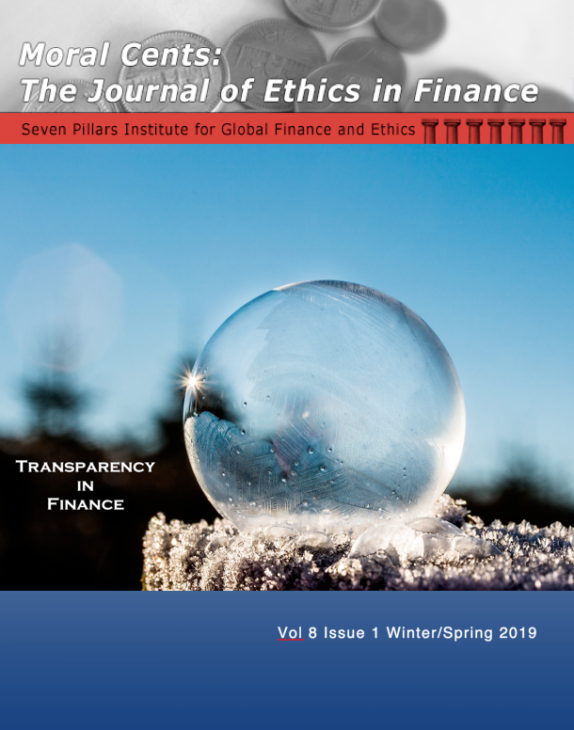Moral Cents: The Journal of Ethics in Finance (Winter/Spring 2019)

“A lack of transparency results in distrust and a deep sense of insecurity.”Words spoken by the Dalai Lama in reference to China’s totalitarian rulers, apply aptly to financial markets as well. Indeed, transparency as a general rule is good practice in any area of human endeavor. In finance, where immense sums of money entice dishonesty, transparency in all transactions and services is vital. This issue of Moral Cents comprises articles that call for enhanced transparency in different spheres of financial services.
Harry Cui argues for greater transparency in pension funds and uses commutative justice as his theoretical foundation. In particular, undisclosed and unanticipated fees such as inactivity fees, contribution charges, exit fees, and platform fees contravene the principles of commutative justice and transparency. Yet, 37% of the largest US state sponsored pension funds report gross returns, without deducting management fees. Cui recommends regulations, such as the UK Stewardship Code and the US ERISA, be strengthened and enforced with greater zeal.
Financial transparency should reveal not just fees but also the impact from and mitigation of climate change. Tom Wilkinson responds to the Financial Conduct Authority’s Discussion Paper Regarding Green Finance. Financial institutions have a moral obligation to disclose the effects of climate change on their operations and profits. In addition, the organizations should disclose steps they are taking to mitigate climate change. Wilkinson suggests improving the framework for comparing company disclosures to help investors and the public rank companies according to how they address their impact on climate issues.
Billie Trinder extends the call for transparency to the use of big data by banks. Financial institutions use big data for purposes such as determining the credit worthiness of customers. Algorithms using big data can become so complex that in retrospect their working and logic is opaque even to their creators. Most obviously, this is an issue of transparency loss. When it comes to banks using big data analytics for key tasks such as credit rating, transparency issues become institutional problems. Trinder would like more human participation throughout the algorithmic decision-making processes to ensure greater transparency and implementation of an ethical framework.
John Francis Diaz rounds out the issue with some recent history pertaining to market transparency. He writes of the case of Best World Resources (BWR) in the Philippines. The case gives some historical context for the enactment of the Philippines Securities Regulation Code of 2000, which no doubt buttressed the market against insider trading. The Code also increased market transparency through mandating investors be provided with up-to-date material information to enable informed investment decisions. The full-disclosure approach required the SEC to review compliance of disclosure documents. The Code also made the signatories (i.e., issuer, underwriters, corporate secretary, directors and related parties) of the registration and disclosure documents, administratively and criminally liable if wrongdoings were uncovered.
The cry for more transparency in financial services leads to effective action as organizations such as the Transparency Task Force engage in this movement. Regulators will hopefully heed the call and pull recalcitrant financial service providers towards greater openness, so we no longer have distrust and insecurity.
Dr. Kara Tan Bhala
Moral Cents: The Journal of Ethics in Finance is published by
Seven Pillars Institute for Global Finance and Ethics
ISSN 2326-5663
Editor-in-Chief: Dr. Kara Tan Bhala
Editor: Eric Witmer
